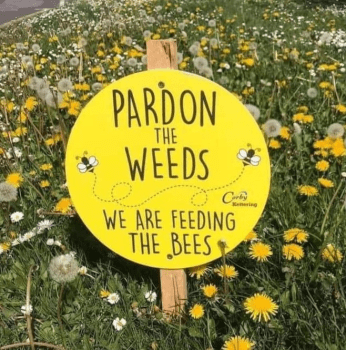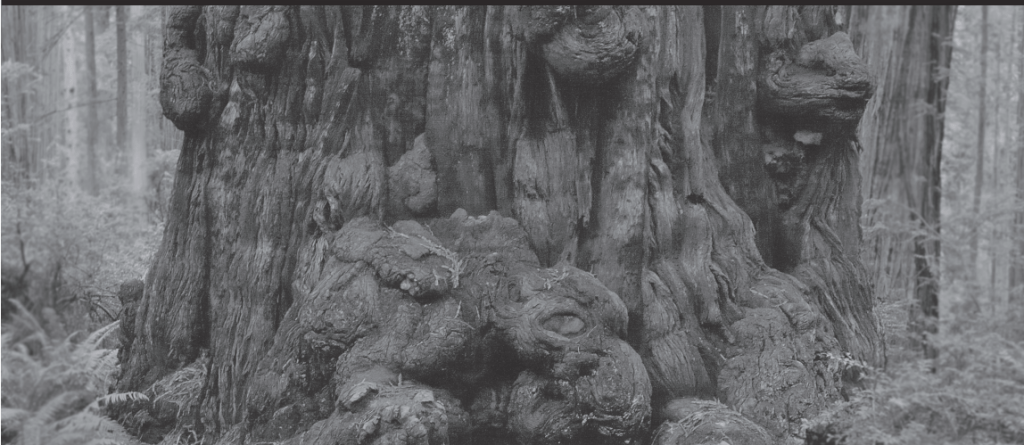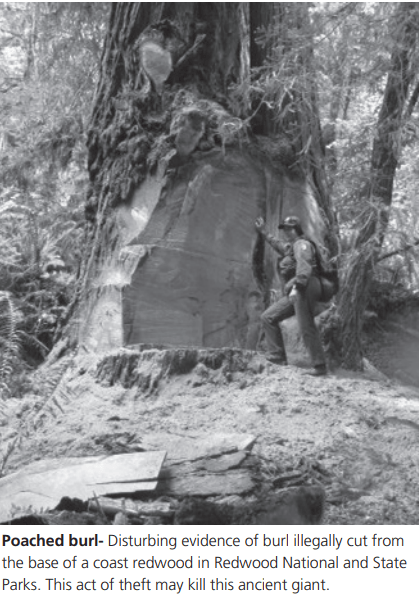Tree Thieves (1) is a non-fiction version of Damnation Spring, a novel that tells the story of the Timber Wars that ended with the death of the logging industry in the Pacific Northwest in the 1970s, 80s, and 90s. Although the industry collapsed throughout the Pacific Northwest, both books focus on the redwood forests of coastal Northern California.
Sequence of Events
When the timber industry began in earnest after the Gold Rush of the 1850s, there were said to be 2 million acres of redwood forest on the coast of California. The demand for timber during the Gold Rush fueled the unrestricted clear-cut methods that decimated the forest, provoking a backlash.
The National Park Service invited three well known conservationists to visit the redwood forests of Northern California, which led to the creation of the Save the Redwoods League in 1918. Two members of that team–Madison Grant and Henry Osborn—were also advocates for eugenics, the control of human reproduction for the purpose of increasing characteristics considered desirable. The author of Tree Thieves, Lyndsie Bourgon, describes their purpose for creating the Save the Redwoods League: “They considered protecting the redwoods as part of a mission to enshrine White, masculine dominance over the wilderness.” (1) Save the Redwoods League purchased several parcels of redwood forest for preservation, setting the stage for the continuing perception of environmentalism as the hobby of wealthy city dwellers, with little understanding of the lives of those who live and work in resource extraction industries such as forestry. The League has acquired a total of 66 redwood forests as of 2018, according to Wikipedia.
In the 1930s the government imposed restrictions on the timber industry that limited clear-cutting methods because of concern about dwindling timber stocks. The industry returned to clear-cutting methods after World War II in response to the demand for new housing. By 1968 90% of redwood forests had been logged, according to Tree Thieves.
Consequences of clear-cut logging
The author of Tree Thieves believes that the turning point leading to the Timber Wars was a flood in 1955 that triggered a landslide that “toppled 1,000 year old redwoods and covered the region in silt and mud.” The landslide was the result of decades of clear-cutting the forest: “During clear-cut logging, topsoil is lost and streams are bulldozed for roads…In Humboldt [County’s] forests, the root system could no longer contain the immense annual rainfall and waterways began to flood. Mangled roots, lack of second growth, and flattened shrubs made the earth unstable and the construction of roads deep in the woods to transport logged wood had hastened erosion and habitat destruction.”
Clear-cut logging didn’t stop after the first flood and landslide and in 1964 another flood and landslide swept through the town of Orick. The town of Orick is at the center of Tree Thieves’ telling of events. Orick is said to be a Yurok word for “mouth of the river,” perhaps referring to Redwood Creek that bisects Orick. Yuroks were one of several tribes of Native Americans who were the first human inhabitants of the region. At the height of the post-war timber boom, there were about 2,000 inhabitants of Orick. The 2010 census downgraded Orick from a town to a “census designated place” with fewer than 400 inhabitants.
These catastrophic floods alerted the Sierra Club to the issue of clear-cut logging and the government was becoming concerned about the environmental devastation it caused. In 1968, the government established the Redwood National Forest, which ended logging in the park. The government believed—or said they believed–the park would create a tourist trade, replacing the logging economy. Timber corporations were compensated by the government for the loss of their properties, but there wasn’t government relief for the loggers.
The Timber Wars
The promise of a tourist industry proved to be a fantasy, which forewarned the loggers of the consequences of expanding the national park that occurred in 1978. This time the loggers fought back and environmentalists organized to engage in that war. In the 1970s, Humboldt County became a rural refuge for hippies fleeing the druggy disorder of cities as described by Joan Didion in Slouching towards Bethlehem. They were the foot-soldiers opposing the loggers in the Timber Wars.
Both sides of the Timber Wars engaged in violence and vandalism, as well as degrading rhetoric. “ARE YOU AN ENVIRONMENTALIST, OR DO YOU WORK FOR A LIVING?” was a typical protest sticker worn by loggers. One of the leaders of the environmentalists, Judi Bari, described the loggers as “the equivalent of the white racists in Mississippi…They’re being used by the system. But they are people who are not real bright who have bought into it.”
The battle lines need not have been drawn between loggers and environmentalists. If they had worked together to find a solution to environmental issues, the battle lines could have been the timber corporations vs. the government. The decision to clear-cut and spray with herbicides was made by the corporations, not by the loggers. Many of the loggers had learned their profession by taking individual trees in the forest, which quickly recovered from single tree removals. They knew that clear-cutting was destructive and they probably would have been glad to return to less destructive methods of logging. Many of them also knew that herbicides used for road clearance and destroying competing vegetation after clear-cuts were poisoning the watershed and sickening their community. That aspect of the story is best told by Damnation Spring.
If loggers and environmentalists had worked together to pressure the government to regulate the destructive aspects of the timber industry, the environmental issue could have been resolved without a war that permanently alienated both loggers and environmentalists. Government has the right to regulate pesticide use and it could restrict clear-cutting, but it didn’t and it won’t. The Timber Wars also alienated some people from environmentalism and others from the logging industry. There is a lesson here for those who wish to learn it.
The loggers were also disrespected by the government. While the plan to expand the national park was being debated, the loggers organized a convoy of logging trucks across the country to Washington DC in 1977. They carved a redwood log into the shape of a peanut, intended as a gift to President Carter, a former peanut farmer, hoping to engage him in a dialogue. President Carter refused the gift and the request for a meeting. He said the peanut-log was a waste of a valuable resource. The logging convoy not only failed, but it subjected the loggers to abuse across the entire country and back.
The decision to expand Redwood National Park in 1978 incorporated the forests protected by the Save the Redwoods League and California state parks into a total of 139,000 acres, protecting approximately 45% of remaining redwood forests. Once again, the timber corporations were compensated for the loss of their properties. This time, the federal government tried to compensate loggers for the loss of their employment by funding a job training program, community development projects, watershed restoration, and direct compensation to unemployed loggers.
The failure of the job retraining effort was very disappointing: “By 1988, $104 million had been spent on about 3,500 people, of whom fewer than 13% had received retraining….’Never have so many given so much for so few,’ one critic noted of the funding.”
The fate of the loggers and their community
When spotted owls and several other forest species were designated as threatened species by the Endangered Species Act in the 1990s, much of the timber industry was also shuttered in Washington and Oregon. Between 1980 and 1998, 23% of logging jobs were lost.
Using the community of Orick in California as an example, Tree Thieves describes the consequences of the loss of the timber industry. Many people moved away. Those who remained pieced together a meager living of odd jobs. Many of those odd jobs were criminal. Poaching of whole trees in the national park is still common, but poaching the valuable redwood burls is more lucrative.
Redwood burls are the tree’s means of recovering from wounds. The burls have artistic patterns in their wood grain that make them valuable to make furniture, art objects, and veneers for the dashboards of luxury cars. The tree is damaged by the removal of its burls and is sometimes killed by the damage.
Tree Thieves interviews many of the former loggers, now poachers. They are an angry bunch who feel justified in their thievery. Their livelihoods and self-respect have been taken from them and they have been subjected to decades of abuse by self-righteous environmentalists and government enforcement. They now feel owed.
Having won the Timber Wars, environmentalists are rarely directly engaged in confrontational encounters. Now the anger of dispossessed loggers is directed at government employees who are trying—with little success—to stop poaching and punish poachers. Government employees are also imposing new restrictions on the communities surrounding the national park, opening new wounds. For example, these poor communities are now prohibited from collecting drift wood on the beach, which was used to fuel wood-burning stoves in the past.
Timber corporations were not blamed for the Timber Wars. They were compensated by the government for the loss of their land. They had already logged much of the land and didn’t see much future in the few forests that remained. They were responsible for much of the loss of employment because they had mechanized much of the work and reduced availability of unlogged forests after clear-cutting for decades. They walked away unharmed.
Making, selling, and using methamphetamines is also a common way to survive in Humboldt County. Those who choose that mode of survival frequently engage in other criminal behavior and their lives are often ruined in the process.
The marijuana trade in Humboldt County is also a popular career choice. Ironically, the damage to the environment caused by large marijuana farms hidden in the forests is one of the consequences of the transition from a logging economy to an odd-job economy.
This scenario is probably similar to many other small towns and rural communities in America. There are devastated communities in former coal country and in the rust-belt where manufacturing industries have been closed as the result of global trade agreements that enabled industries to move to countries with lower labor costs. Those are the places where angry people no longer trust the government, where environmentalists and other “experts” are hated. And those are the places where desperate, resentful people have turned to an angry, resentful politician to lead our country. We reap what we have sown.
- Lyndsie Bourgon, Tree Thieves: Crime and survival in North America’s woods, Little, Brown Stark, The Hatchett Group, 2022. All quotes are from this book. Some factual information is from Wikipedia.






